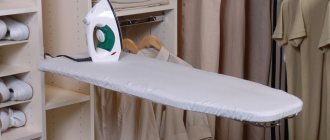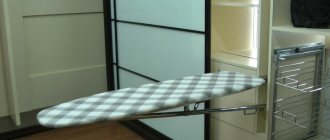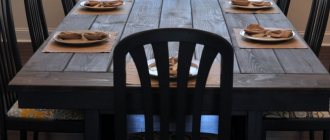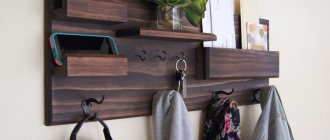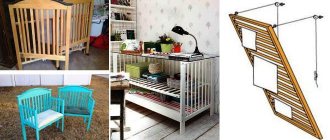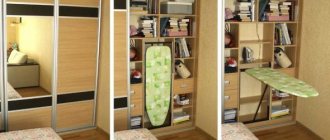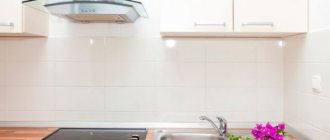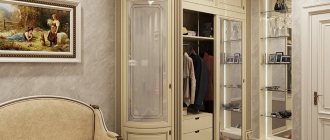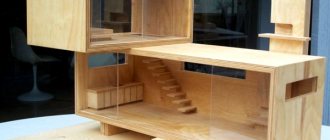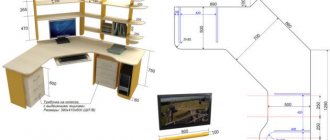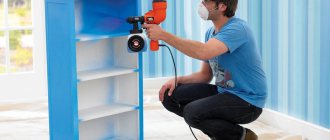Types of built-in ironing devices
There are plenty of options for ergonomic, practical ironing devices that relieve space and fit seamlessly into the interior.
Folding
There are several types of folding ironing boards, including the following:
- Classic wall-mounted version of the ironing board. The tabletop-lid (solid wood, laminated chipboard or moisture-repellent plywood) is attached to a frame-frame with a simple folding mechanism, and it is attached to the wall (at two or four points). When folded, the board is positioned vertically; when working, it is positioned horizontally on the floor. There are two possible methods of fixation: without a supporting leg or for (reinforcement) on a stand resting on the floor.
When installing the classic wall-mounted version of a built-in ironing board, the frame to which the lid is attached remains open. Metallized frame pipes will fit perfectly into a loft or industrial style, emphasizing its deliberate simplicity; disharmony with others is possible.
If the ironing device is hidden in a box with a sliding decorated panel or a hinged door, imbalance can be avoided.
- Ironing board with wall mirror. A two-in-one variation: on the outside there is an elegant reflective surface of any shape or size, on the inside there is an interior device for ironing clothes. The mirror sheet can be hinged - sliding to the side, or hinged - a traditional single-leaf structure using canopies, a box and a movable sheet. An additional advantage of combining two functionalities is unloading the scarce space of a small apartment and its visual expansion. A built-in ironing board with a mirror can be integrated into any interior style by framing the reflective surface with a suitable finishing or decorative material (baguette, molding) - natural wood, wild or ornamental stone, stucco, plastic.
Retractable
A folding version of the ironing board, placed inside a furniture box (in a cabinet, chest of drawers). It is fixed on the guides by the widened part of the base, the tabletop “breaks” in the middle, folding in half - the narrowed part is laid on the wide one - face to face. The dimensions of the retractable ironing board are proportional to the size of the drawer, stability depends on the quality of the guides.
Built-in
Maximum space saving. The optimal variation for small apartments. It is usually made to order when purchasing a wardrobe or installed with your own hands in both a wardrobe and a kitchen cabinet (a labor-intensive but functionally rewarding process of filing partitions, installing a fastening system and fixing structures).
In a large ironing wardrobe, it is more advisable to install not a static board, but a rotating or folding board with a built-in socket. In the classic variation of the cabinet with swinging doors - with a folding device and a light weight structure.
Varieties
There are many options for wall-mounted ironing boards, so it is important to know about all the different varieties available before making your final choice.
There are these options:
- folding;
- built-in;
- folding and folding;
- suspended and mounted.
The folding type is the most popular due to the maximum strength of the product, as well as stability, which allows you to safely leave the iron on the surface without fear of it falling. This option can last for many years, delighting the owner, being easy to use and reliable. Among the design features of this option are the following:
- The tabletop is fastened to a metal frame with a folding mechanism, which, in turn, is attached to the wall;
- a folding structure, which is placed on the wall, can have different dimensions;
- it is difficult to find a board attached in this way indoors, because a suitable location is chosen for it;
- To improve the system, a cabinet-type structure is built around the board, or it is purchased initially, taking into account the required dimensions.
A folding ironing board can be hidden behind a mirror, which will solve several problems at once: a convenient place for the board, expanding the space due to the mirror, the opportunity to look at yourself in full height, thanks to the appropriate dimensions of the ironing surface.
Built-in ironing boards can be represented by the following options:
- a cabinet with a mirror where the board is placed;
- hinged wardrobe or wardrobe;
- a pencil case or hanging cabinet with shelves that can be placed in any room.
A very convenient option is to integrate the ironing surface into a drawer or a separate shelf. In this case, a lifting mechanism is additionally installed, which lifts the board higher during operation and lowers it to the level of the shelf, which allows you to hide it, making it completely invisible. There are also built-in designs that can be rotated to iron any items with maximum comfort.
A folding ironing board is a structure whose surface consists not of one piece of wood or metal, but of several. Often there are only two. This option makes it possible to reduce the area of the board, which makes it easier to place it in any closet, shelf or cabinet. The ironing process does not suffer in any way, only the procedure for setting up the board and its cleaning becomes more complicated, due to the additional action of arranging the parts, fixing them and reverse actions.
A suspended wall structure is not always framed by a cabinet or similar furniture; in some cases, the board is simply attached to the wall. This is convenient if the room is intended for cleaning and other similar activities. Due to its simplicity, the ironer can be easily brought into working position and also quickly removed. In this case, it is important to purchase reliable fastening mechanisms and screw the board well to the wall.
A wall-hung structure is not much different from a wall-hung structure; the only difference is that the ironing surface in this case is autonomous; it is hung on mounts that are already in the wall or any other surface. You can store parts of a single whole either in one place or in different ones, this does not affect the functionality in any way.
The choice of option will be determined by the room in which you want to install the ironing board, the dimensions of the room, in addition, it is important how often the housewife will use the surface and what size items she usually irons. Taking all these factors into account can help you choose the most suitable option.
To make the right choice, it is important to know not only the types of devices, but also the popular models of boards that currently exist on the market.
Among the most relevant are the following.
- Iron Slim is a transformer because it is built into a cabinet that is hidden behind a mirror; A special feature of the model is the socket, which is already built into the cabinet, and for an impressive appearance, the entire structure is made in a metallic shade.
- Shelf on Iron Box Eco - this option is in many ways similar to the previous one, as it is built into a closet, but the distinctive feature will be two shelves that are added inside to make it possible to place clothes or necessary small items.
- Asko Hi 115 T - is represented by a completely different modification, which is installed in a cabinet drawer, which can significantly save space in the room; in addition, the entire board with the mechanism is made of steel, which allows you to evenly distribute the load, which significantly extends the service life of the equipment.
There are a lot of options for wall-mounted, built-in and folding models, so before buying, it’s worth comparing the main characteristics, and it’s best to see the product in person, try folding and unfolding it. Not all brands produce such a line; some still give preference to the classics, those models that are installed anywhere in the room and are autonomous; Among these we can highlight the well-known and popular company Ikea.
DIY built-in ironing board
Several built-in variations are possible in the cabinet:
- retractable - a complex design for homemade craftsmen with specialized telescopic mechanisms;
- hidden - in a niche behind shelves or a mirror - requires stable carpentry skills;
- folding - with a simple and reliable fastening and fixing mechanism.
The folding option is easy to implement. The structure consists of:
- ironing surface (you can use a modernized base of a folding floor board);
- folding device;
- frames;
- support attached to the rear wall of the cabinet.
For a DIY installation, it is better to use the practical installation of a static board to the middle shelf (at lumbar level) using door awnings, piano hinges or butterfly hinges (ideally hidden hinges). The upper shelves above the ironing tabletop are filed down so that it can be placed freely when folded behind a closed cabinet door.
The support must be attached to the wall with the same hinges that were used for the table top, and hooks must be installed under it on the bottom (back) side of the board. During operation, the lower support is folded back and secured with hooks to the board lowered onto it.
This version of a hand-made ironing device is stable and maneuverable.
Rules for choosing functional ironing boards
When preparing to purchase or accept the ordered and installed drawers and built-in ironing boards on the wall, check:
- folding mechanism - smooth lowering, no noise, there should be no doubt about the quality and durability of the material;
- reliability of fastening of the support to a box, shelf or wall and stability of the structure - swaying, dangling in a horizontal position will unbalance the fastener, leading to injury during ironing and breakage;
- weight of the structure - the wall thickness should not hold, but calmly hold the total mass of the ironing board, linen and iron;
- warranty promises and obligations of the manufacturer and installer: no guarantees - refusal to use.
pros
When clothes are ironed, the question always arises: where to hide the board? Often they put it in a room or put it against the wall behind the furniture, but it either doesn’t look very good or takes time. A simple solution here is the option of a built-in ironing board.
This is the case that combines all the main advantages
:
1
. Easy to install. To use the board as simply as possible, screw a couple of fasteners to the wall, screw the board in - and that’s it.
2
. Space saving. You and your children will no longer limit your movements - the board is hidden in the closet, which gives additional free space in the room.
3
. Practicality. To iron any item, simply take the board out of its closet, and when you're done, hide it.
4
. Appearance . The board can easily be designed to match the stylistic option of the interior, and harmoniously complement the space of the room.
5
. Stable and durable design. These properties ensure a long service life of the board. The BELSI built-in ironing board has a reliable metal frame and thoughtful details.
Some popular models from top-rated manufacturers
Among the available options for built-in boards, there are those that you can follow when making devices for ironing clothes/clothes yourself, or buy and use for their intended purpose - they will last a long time and faithfully. I am glad that they were produced mainly in Russia and the CIS - TriYA, IRON SLIM, Shelf-On, “Lubimy Dom”:
- wall-mounted ironing board “Mermaid” with a chrome-plated pipe frame and an automatic lock - installed quickly and easily, taking up only 8 cm from the wall;
- built-in “Rocket” board with variable installation methods (inside and outside the cabinet), mounting on the right or left rack, with a varied set of ironing surfaces and, what is especially valuable, its maximum permissible load is 70 kg;
- wide built-in ironing board attached to the wall with reinforced brackets with a mirror cabinet from IRON SLIM;
- compact ironing board Astra-mini Eco, built into a cabinet with hinged doors, with a plastic lock included - child protection.
In a drawer
Another very interesting option for storing the ironing board is in a drawer.
Moreover, it can be either traditional horizontal or vertical. This is very convenient if you have a small board and a chest of drawers or a cabinet of sufficient depth. Today there are also special built-in ironing boards that come with furniture. Pay attention to these options if you are going to update your furniture.
Reviews
Our daughter is a needlewoman. She sews toys and clothes for them. Parts and workpieces need to be ironed. There is a stationary board of a folding type, but it is inconvenient to lay it out all the time, and the children do not want to litter it. We installed a “Mermaid” wall board in her room - it’s compact and easy to handle in children’s hands. When unfolded, it leaves a good gap - it’s convenient to iron both small pattern pieces and our (adult) things. Everyone is happy.
Egorov Dmitry When ordering the wardrobe, we immediately provided an ironing board with a rotating function. They installed everything quickly, neatly, without unnecessary play - everything is clear and thought out: the tabletop is at the right level - your hands don’t get tired and your lower back doesn’t ache from unnecessary bending, doesn’t sag or wobble during ironing. We've been using it for four months now - absolutely no complaints. Both my wife and I are happy: she’s comfortable, and I’m comfortable.
My husband gave me a gift - he ordered an ironing board with a mirror cabinet from IRON SLIM. This is just lovely! The house is always in order. And it gave in to me instantly - no difficulties either during opening or assembling. I managed it right away. Now I want to give my daughter-in-law the same birthday present.
Source: hozsekretiki.ru
Do-it-yourself ironing board built into a closet: instructions
An ironing board built into the closet is a practical solution that allows you to save space in your apartment. It easily folds back when you need to iron clothes, and immediately puts it back in place after use. The finished design is slightly more expensive than conventional ironing devices, but you can make it yourself if you have the right tools and some woodworking skills. A board made by yourself will fit exactly in size and fit better into the interior, because it can be decorated taking into account the design of the room.
Ironing board on the wall
Often the space behind the door or on the walls is not used. The board does not require much space, so you can safely hang it on the walls. This will not interfere with your movement around the room and will save space. If you decide on this option, choose the upholstery of the ironing board to match the color of the curtains, furniture or accessories so that it decorates the interior and becomes part of it.
To secure the ironing iron to the wall, use regular coat hooks, which are usually used in hallways. It is enough to fix two such hooks on the wall and you can already hang your ironing board on them. Just make sure that the fastenings are reliable and can withstand the load. For these purposes, choose metal hooks.
Materials and tools
To work you will need:
- jigsaw;
- construction stapler;
- drill with wood drills;
- metal ruler;
- compass;
- circular saw and fine-toothed disk;
- sandpaper of different grain sizes or a grinder;
- self-tapping screws;
- pencil for marking;
- piano or hinge hinges;
- scissors;
- hammer.
Materials that will be required to make a built-in board in a cabinet:
- furniture board, sheet of ordinary or moisture-resistant plywood or chipboard with a minimum thickness of 12 mm;
- 2 bars 40*70 mm or a sheet of plywood 10 mm thick;
- wood glue;
- thick fabric for backing;
- natural sustainable fabric for decoration.
How to make a classic system?
To start making a classic ironing fixture, in addition to the base board and upholstery fabric, you will need to prepare the following materials:
- wooden bars for making legs, the length of which is 110 cm - 3 pcs.;
- wooden blocks 30 cm long to make stops - 2 pcs.;
- ordinary self-tapping screws;
- M10 bolts.
The tools we will use are:
- electric jigsaw;
- wood drill bits and drill;
- staples and furniture stapler or upholstery nails along with a hammer;
- screwdriver
Important! You can choose a completely different length of the wooden blocks for the legs, depending on what is convenient for you.
Before you understand how to make an ironing board with your own hands, prepare all the tools and materials. Then:
- You should round one end of the board using a jigsaw.
- Next, using a drill, drill through holes D 8 mm in the long bars. Two holes need to be drilled: one - approximately in the middle, but the second - a few centimeters from the edge.
- Using a plug drill, make a hole in 2 of the 3 blocks near the holes in order to recess the bolt heads into it.
- After this, connect all 3 future legs with bolts through the middle hole, turn the block in the middle by 180⁰.
- Take a small block and drill an 8 mm through hole in it, approximately 3 cm from the edge. You must fill in the hole on either side with a sample.
- Then bolt the piece together to one of the large pieces of wood through the end hole.
- Do the same with the remaining short block, only now attach it to another long leg.
- Turn the small blocks by 90⁰, attach them with self-tapping screws to the surface of the board. Do not forget to retreat approximately 18 cm from its edge.
- You've got a fixed ironing board support. To attach the movable leg while laying out the board, you can make a recess in the required place using a jigsaw or fill another block into which the leg will rest.
- The final stage is to install your board, check its horizontal position and stability. If necessary, trim the legs.
- After this, cover the ironing surface with a thick fabric with padding using a stapler or upholstery nails.
Work order
Having prepared the necessary materials and tools, they proceed to making the board.
The process of its creation consists of three points:
- marking and cutting the main part;
- covering the board;
- installation in a storage location.
Marking and cutting
On a sheet of plywood, furniture board or chipboard, outline the contours of the future board. The standard product is about 40 cm wide, 120-130 cm long, with a gradually tapering rounded edge. If desired, these dimensions can be easily increased or decreased. You can first make a pattern on cardboard or thick paper, and then transfer it to wood. To form a rounded edge, it is recommended to use a compass, and if you don’t have one, use improvised means (saucer, roll of tape, any cylindrical object of suitable diameter).
Step-by-step instruction
Installation includes work with the frame and ironing board. Depending on the type of structure, work begins by creating a niche.
Important! When installing into a wall, it is necessary to legally coordinate the work. This will save you from possible problems with regulatory authorities.
- An ironing board is cut out, about 125 mm long and about 40 mm wide. Change sizes based on the room and your own preferences.
- Create a frame for installation. The depth is calculated from the size of the chrome pipe, the thickness of the rear wall, and the protruding elements of the flange.
- After creating the frame, install the jumper in the frame. It should rotate freely. To do this, it is best to use special bolts for upholstered furniture. They don't perform. Hole size – 10 mm. They are drilled at a distance of 10 mm from the edge, 15 mm from the front, 110 mm from the bottom. If the bolts have small protrusions, cut the header approximately 6mm less than the internal width of the frame.
- Attach the jumper to the guides. For fastening, two methods are used: a bolt with a turned head or a long block. The second option is easier. The block, about 100 mm long, is quickly driven in with a mallet. To do this, place the tube on the wood and hit it from the other side. Make a hole in the center of the hammered block. Attach to self-tapping screws on the inside of the guides.
- On the other hand, handles are installed. They are necessary to remove the fixation. Trim the bolt for a durable fastener.
- Bend the corner on the guides where the handle is located 45 degrees inward. This must be done before fixing it to the structure.
- Bend the plate inward by 45 degrees and attach it to the frame.
- Fix the fastening of the central tube exactly in the middle. Immediately insert the tube and tighten the screw to secure it.
- The remaining tube structure is assembled.
- To ensure that the ironing board is parallel to the floor, the guides must be properly attached. Take into account the thickness of the board. Therefore, it is necessary to make the tube hang in the air 16 mm from the wall (approximately). They make notes.
- Pull out the guides. Fastened with self-tapping screws.
- Check the angle of the resulting structure in the extended state. The angle with the table should be 90 degrees. Also check in a vertical position.
- For safety, you can install latches.
- Then install the sawn board. Cover with material using a stapler and staples.
The final stage is the installation of the door or sash. Several options are used: swing doors or a retractable system. The last option is considered the most compact, because it saves space and does not interfere with work. This depends on the location of the ironing board. Paintings, mirrors, trim around the edges and other options are used as decorative elements.
This DIY design does not require a lot of time and money. It takes up little space, fits into the interior externally, and is easy to use.
Fabric covering
Before starting this procedure, you should attach the rotary loops to the straight edge of the board at both ends.
First, the workpiece is covered with thick fabric. You can use a towel, wool blanket, or other heat-resistant material.
Lay the fabric face down on a flat surface and place a board on it so that the loops are on top. Wrap the edges of the material onto the workpiece. Fix them so that the fabric is slightly stretched. A construction stapler is used for fastening. Excess fabric around the entire perimeter is cut off with scissors, leaving 5-10 mm for allowances. If in some places the staples do not fully penetrate the wood, hammer them in with a hammer.
In the same way, cover the workpiece with decorative fabric (cotton, linen or other natural and heat-resistant material are suitable).
Installing a board in a closet
You can secure the part in a storage location (in a cabinet or niche of a suitable size) in different ways.
The simplest and most reliable are two options:
- using a folding support;
- on bars.
Folding support
To create a leg you will need a sheet of plywood 10 mm thick. The outlines of the future part are marked on it. Its shape can be any; the simplest option is a rectangle with a height equal to the distance from the floor to the level at which the board will be placed.
Cut out the workpiece using a jigsaw. Treat with a grinding machine or sandpaper. If desired, the leg can be painted or varnished.
The finished leg is attached to the board using hinges. This way the product will simply fold back and be easily put back into the closet.
Bruschi
For the second option, you will need 2 bars of 40*70 mm, 15-20 cm long. Their cuts will serve as a support, so they must be straight and even.
In the bars on the 40 mm side, using a drill, drill 2 through holes for fasteners. Having smeared this side with wood glue, apply it to the board, use a screwdriver to screw the bars with screws of suitable length and size.
To determine the optimal position of the bars, you need to temporarily connect the hinges on the board with a wooden batten. After this, place both bars on a section of the straight edge of the board that is free from loops so that they rest against the batten. In this position, they will reliably hold the structure in weight.
The final step is to secure the product in the cabinet. Having chosen a storage location and determined the level at which the board will be located, fix it using the previously installed hinges and screws.
It’s easy to make a built-in ironing board using the instructions. Its manufacture requires simple materials, and all work can be done independently.
Source: svekrovi.net
Manufacturing process
Let's get started!
I took this regular ironing board.
Next, we take it, turn it over and put it on the floor.
Now we unscrew all the existing fasteners.
Next, we take the unscrewed rack and move it forward to the narrow part; previously the fastening was in the opposite direction. We place it so that the stand fits evenly along the length of the board, then, when everything is ready, we fix it with self-tapping screws. The front part will serve as a support.
Now all that remained was to secure the supporting part, which determines the height of the board.
Before starting the remodeling, I measured the pitch of the support legs, choosing the optimal height, since in the future there will only be one, the other two will not be used, but, by the way, they are not really needed.
Then we attach the stop in the right place.
The following happened.
Now it's time to move the converted structure to the loggia.
In order for the ironing board to be able to recline, I took two hinges that I had, thanks to them the reverse part of the board will receive support and the ability to recline.
I placed them at the required level and made markings for the holes.
Drilled holes. I secured it with dowels and screws.
Next, I unscrewed everything, put a new cover on the board, since the old one was rendered unusable, and fixed everything back.
The next step was to install the locking element, it will hold the board in the folded position.
The latch seemed to me to be the most suitable element for this.
Fixed it at the desired height.
Next, the second element from the latch was installed directly on the board itself.
When folded it looks like this.
That's all, the board is ready for use.
Built-in ironing boards in the cabinet and other optimized models
An ironing board is equally necessary for both large families and single people. But sometimes it’s so difficult to find a place for this important thing. You always have to pull it out from somewhere, lay it out, and after ironing, hide it again for a long time. These manipulations take a lot of time. So humanity had to think about modernizing the ironing device. This is how many unusual models appeared, and the most popular was the built-in ironing board in the closet. Built-in boards save a lot of space, they are easy to unfold and assemble, so ironing is perceived as a fun and easy process.
Folding products
They are quite practical and at the same time unusual. All guests coming to the house will see only a beautiful one, and only you will know that behind it lies another functional household item.
On a note! When the need arises to iron things, you will only have to fold back the board and fix it in a comfortable position, and after ironing, when the work is completed, you need to return everything to its previous position.
Such a design solution will “unload” the interior, and nothing will prevent it from being stylish and aesthetically pleasing.
Types of ironing structures
Folding
The most important qualities of an ironing board are stability and strength. A folding ironing board built into the wall fully meets these criteria. Its tabletop is attached to a metal frame with a folding mechanism, which is already attached to the wall.
The dimensions of the ironing board built into the wall can be completely different, because on the wall, as a rule, there is enough space even for the largest models. Hiding the folding board is very simple. On the wall it is placed in a wooden frame. A door or sliding panel decorated with decorative elements is attached to the top of the frame. So wall mounts are more reliable in this regard.
A small whiteboard cabinet on the wall can also be functional and be used to store necessary supplies.
Whiteboard built into mirror
A very practical, but rather unusual solution is a panel with a mirror with an ironing board. All guests who come to the house see just a large wall mirror, but in fact there is a board hiding behind it. When you need to iron, the mirror simply moves to the side and the compact ironing surface lowers down to a horizontal position.
About wall models
The design of such a product is actually simple and includes three main elements:
- fastening – a durable “frame”, which can be equipped with a bracket for more reliable installation to the wall;
- folding system (usually metal or plastic);
- Actually, the board is a surface on which you can iron things and place an iron.
More advanced designs additionally include a timer, a separate add-on for the iron, an ironing sleeve and other elements.
Advantages and disadvantages
An ironing board, securely hidden from prying eyes, is the dream of any housewife. None of the guests will ever guess that behind a beautiful wall mirror or behind the door of a magnificent designer wardrobe hides such a banality as an ironing board.
Such structures have several positive qualities:
- the board is not an eyesore for house guests;
- does not spoil the design of the apartment;
- all residents of the house can move freely around the apartment without fear of accidentally catching a board, iron or linen;
- ease of use;
- you can use a very large board;
- safety during operation.
There is only one drawback to such boards - a slightly higher price than classic models. But this cost is quite justified. Some housewives also say that while ironing it is impossible to move to another place, because the board is stationary.
But still, retractable and folding boards are chosen by people who think rationally and do not want to clutter their living space with unnecessary household elements.
How to choose the right built-in whiteboard
Buying an ironing board is a complex task that requires taking into account a large number of nuances. It is best to seek help from specialists who will tell you the features of each model and warn about their shortcomings. If you choose a product yourself, you need to pay attention to the following characteristics:
- Size. You need to buy a board that, after installation, will not interfere with the free movement of people around the apartment. To eliminate the possibility of error, you should make all the necessary measurements in advance.
- Weight. This indicator is important when choosing products that will be attached to a thin cabinet wall. If the weight is too heavy, the device may fall and break something in the apartment.
- Sustainability. When ironing, you can never rule out the possibility of getting burned. To prevent this from happening, the foundation must be stable. In addition, a shaky structure will cause inconvenience to the owner.
- Quality of support. To prevent the product from falling out of the cabinet or niche, it must be equipped with a reliable lock. This structural part is made from a variety of durable materials.
- Reliability of the mechanism. The device that allows you to raise and lower the board should work without any problems. When purchasing a product, you should ask the seller about the material from which the mechanism is made. It must be strong and durable.
